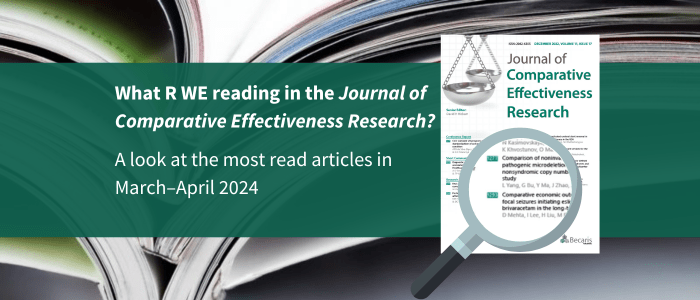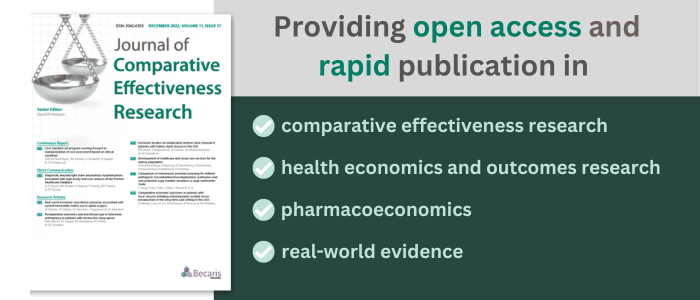What R WE reading in the Journal of Comparative Effectiveness Research? A look at the most read articles in March–April 2024

Our bi-monthly column curating the most widely read content published in our partner journal, the Journal of Comparative Effectiveness Research (JCER). Here we select the top-read articles in March–April 2024.
Access in all areas? a round up of developments in market access and health technology assessment: part 4
Alice Beattie et al. and colleagues (Lane Clark & Peacock, UK) explore recent advancements in market access, including the pricing agreement of Libmeldy® facilitated by the Beneluxa Initiative, financial implications of managed entry agreements in Italy, restructuring of Agenzia Italiana del Farmaco (AIFA), collaboration between FINOSE and the New Expensive Drug (NED) section of the Nordic Pharmaceutical Forum.
R WE ready for reimbursement? A round up of developments in real-world evidence relating to health technology assessment: part 15
Also by the team at Lane Clark & Peacock, UK, Sreeram Ramagopalan et al. discuss real-world evidence (RWE) guidance from the leading oncology professional societies, the American Society of Clinical Oncology and the European Society for Medical Oncology, and the PRINCIPLED practical guide on the design and analysis of causal RWE studies.
Unmeasured confounding in nonrandomized studies: quantitative bias analysis in health technology assessment
This paper discusses the challenges of unmeasured confounding in non-randomized studies and the role of quantitative bias analysis (QBA) in addressing this issue in the context of health technology assessment (HTA). The article highlights key considerations for applying QBA in the HTA setting, including the need to balance methodological complexity with ease of application, and ensuring the methods fit within the existing frameworks used by HTA bodies to assess evidence. The authors call for, “collaboration between academia, industry and HTA agencies to further increase the awareness of the potential of QBA in HTA and to develop best practices for their use.”
Micronized purified flavonoid fraction in the treatment of hemorrhoidal disease
Here the authors review and summarize the clinical evidence for the efficacy of micronized purified flavonoid fraction (MPFF) in the treatment of acute hemorrhoidal disease, discussing the acceptability of MPFF and its position in current guidelines.
Treatment of patients hospitalized for COVID-19 with remdesivir is associated with lower likelihood of 30-day readmission: a retrospective observational study
This retrospective observational study examined the association between treatment with remdesivir and 30-day readmission rates for patients hospitalized with COVID-19. The study found that treatment with remdesivir was associated with a lower likelihood of 30-day readmission compared to patients who did not receive remdesivir, building on previous clinical trial data that demonstrated the efficacy of remdesivir in treating hospitalized COVID-19 patients, and providing real-world evidence on its potential to improve long-term outcomes.
 The Journal of Comparative Effectiveness Research welcomes unsolicited proposals for articles across a broad range of topics in comparative effectiveness, health economics, outcomes research, market access and real-world evidence. If you are interested in contributing to the journal and being part of our ‘most read’ list, please get in touch with the Editor of JCER, Laura Dormer or submit an article directly here.
The Journal of Comparative Effectiveness Research welcomes unsolicited proposals for articles across a broad range of topics in comparative effectiveness, health economics, outcomes research, market access and real-world evidence. If you are interested in contributing to the journal and being part of our ‘most read’ list, please get in touch with the Editor of JCER, Laura Dormer or submit an article directly here.






